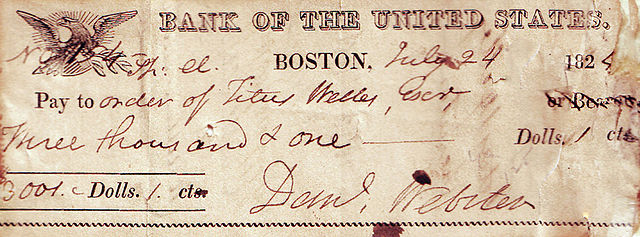The Bank War was a political struggle that developed over the issue of rechartering the Second Bank of the United States (B.U.S.) during the presidency of Andrew Jackson (1829–1837). The affair resulted in the shutdown of the Bank and its replacement by state banks.
Cartoon depicting the political conflict between Andrew Jackson and Nicholas Biddle over the Second Bank of the United States
The north façade of the Second Bank of the United States, facing Chestnut Street (2013)
President Andrew Jackson
President of the Second Bank of the United States, Nicholas Biddle
Second Bank of the United States
The Second Bank of the United States was the second federally authorized Hamiltonian national bank in the United States. Located in Philadelphia, Pennsylvania, the bank was chartered from February 1816 to January 1836. The bank's formal name, according to section 9 of its charter as passed by Congress, was "The President, Directors, and Company, of the Bank of the United States". While other banks in the US were chartered by and only allowed to have branches in a single state, it was authorized to have branches in multiple states and lend money to the US government.
The north façade of the bank on Chestnut St.
An 1824 draft on the bank written and signed by Daniel Webster, its attorney and the director of the Boston branch
A promissory note issued by the Second Bank of the United States, December 15, 1840, for the amount of $1,000
A Democratic cartoon from 1833 showing Jackson destroying the Second Bank with his "Order for the Removal", to the approval of the Uncle Sam-like figure to the right, and the annoyance of the bank's president, shown as the Devil himself. Numerous politicians and editors who were given favorable loans from the bank run for cover as the financial temple crashes down.








